Olympus DS-4000 User Manual
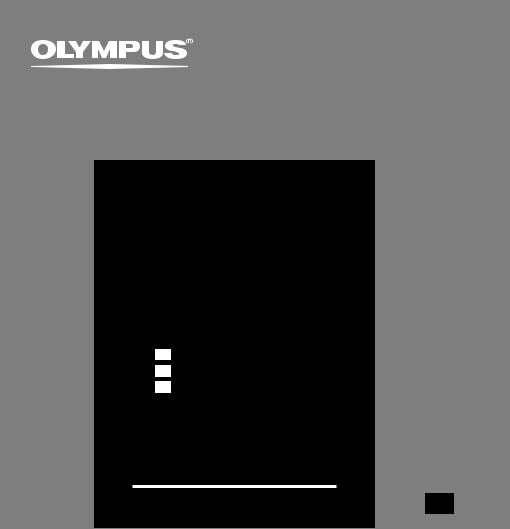
DIGITAL VOICE
RECORDER
DS-4000
INSTRUCTIONS
EN INSTRUCTIONS
FR MODE D’EMPLOI
DE BEDIENUNGSANLEITUNG
Thank you for purchasing an Olympus Digital Voice Recorder.
Please read these instructions for information about using the product correctly and safely.
Keep the instructions handy for future reference.
To ensure successful recordings, we recommend that you test the record function and volume before use.
EN

Table of Contents
Table of Contents ...................................... |
2 |
Safe and Proper Usage ............................. |
4 |
General Precautions .................................. |
5 |
1 Getting Started |
|
Main Features ............................................ |
9 |
xD-Picture Card ....................................... |
10 |
Identification of Parts ............................... |
11 |
Installing Batteries ................................... |
13 |
Charging Battery ...................................... |
14 |
Information Regarding Rechargeable |
|
Batteries ............................................ |
15 |
Turning ON the Recorder ........................ |
16 |
Power Save Mode ................................... |
16 |
Setting Time/Date (TIME&DATE) ............ |
17 |
Inserting and Ejecting a Card .................. |
19 |
2 Basic operations |
|
Recording ................................................ |
21 |
Playing ..................................................... |
25 |
Erasing ..................................................... |
27 |
3 Other functions |
|
Menu List ................................................. |
31 |
Learning to Use the Menu ....................... |
32 |
Setting Priority Levels ............................. |
33 |
Setting Job Data ...................................... |
34 |
Formatting the Card (FORMAT) .............. |
36 |
4 Managing Files on Your PC |
|
DSS Player Software ............................... |
38 |
Installing DSS Player Software ............... |
40 |
Uninstalling DSS Player Software ........... |
41 |
Using Online Help ................................... |
42 |
Connecting Recorder to PC .................... |
43 |
Running DSS Player ............................... |
45 |
Window Names ....................................... |
47 |
Downloading from Recorder to PC .............. |
48 |
Playing a Dictation File ............................ |
50 |
Changing User ID (Author ID) ................. |
51 |
Sending Dictation Files/Receiving |
|
Document Files ................................. |
52 |
2

5 Other Information |
|
Alarm Message List ................................. |
56 |
Troubleshooting ....................................... |
57 |
Accessories (Optional) ............................ |
58 |
Specifications .......................................... |
59 |
Technical Assistance and Support .......... |
60 |
Using the Online Manual
When you install the DSS Player Pro on your PC from the CD-ROM, you can use an online expanded version of this instruction manual, allowing you to learn more about the digital voice recorder.
If the DSS Player is installed, click the [start] button, select [All Programs], then [ OLYMPUS DSS Player Pro], then click [DS-4000 Instructions]. You can read more about the items listed below.
Dealer Option Items ................................ |
18 |
A, B Programmable Buttons .................... |
18 |
Using the Variable Control |
|
Voice Actuator (VCVA) ...................... |
27 |
Hands-free Recording ............................. |
28 |
Recording Monitor ................................... |
28 |
Locking Files (LOCK) .............................. |
37 |
Index Marks ............................................. |
38 |
LCD Display Information ......................... |
39 |
Setting Option Item .................................. |
45 |
Uploading from PC to Recorder .............. |
61 |
Direct Recording/Editing on PC ............... |
62 |
Changing a Folder Name ........................ |
64 |
Editing File Comments ............................ |
64 |
Using Voice Recognition |
|
Software (Optional) ............................. |
65 |
USB Microphone/USB |
|
Speaker (USB AUDIO) ........................ |
69 |
Setting E-mail/FTP Service ..................... |
75 |
Using the Recorder as a |
|
Reader/Writer ...................................... |
82 |
1
2
3
4
5
3
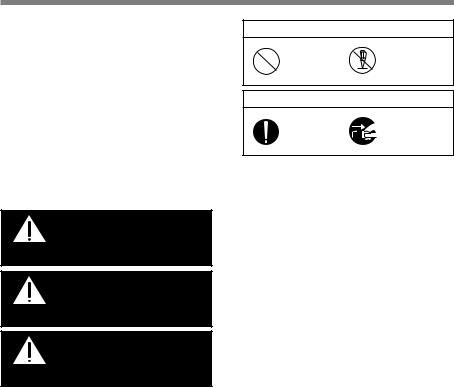
Safe and Proper Usage
Before using your new recorder, read this manual carefully to ensure that you know how to operate it safely and correctly. Keep this manual in an easily accessible location for future reference.
Important Safety Precautions
Certain symbols are used in the user’s manual and on this product to help protect users, their surroundings, and their property from possible injury or damage. Please familiarize yourself with the following definitions and meanings for each symbol before reading the precautions.
Signifies danger which may result in serious
Danger injury or death.
Indicates items or actions which may cause serious
Warning injury or death.
Indicates items or actions which may result in damage
Caution or personal injury.
Symbols prohibiting a specific action
Do not
Prohibited disassemble
Symbols requiring a specific action
Mandatory |
Unplug from |
|
power outlet |
||
|
Convention Used In this Manual
•The word “card” is used to refer to the xDpicture Card.
•The word “DSS Player” is used to refer to the DSS Player Pro Dictation Module in Windows environment and DSS Player for Mac in Apple Macintosh environment.
•The Notes at the bottom of a page are used for additional information, exceptions, or related events.
•Words in uppercase form such as PLAY or REC are used to describe a function, button, or switch position on the recorder.
4

General Precautions
●Do not leave the recorder in hot, humid locations such as inside a closed automobile under direct sunlight or on the beach in the summer.
●Do not store the recorder in places exposed to excessive moisture or dust.
●Do not use organic solvents such as alcohol and lacquer thinner to clean the unit.
●Do not place the recorder on top of or near electric appliances such as TVs or refrigerators.
●Avoid recording or playing back near cellular phones or other wireless equipment, as they may cause interference and noise. If you experience noise, move to another place, or move the recorder further away from such equipment.
●Avoid sand or dirt. These can cause irreparable damage.
●Avoid strong vibrations or shocks.
●Do not disassemble, repair or modify the unit yourself.
●Do not operate the unit while operating a vehicle (such as a bicycle, motorcycle, or go-cart).
●Keep the unit out of the reach of children.
<Warning regarding data loss>
Recorded content in memory may be destroyed or erased by operating mistakes, unit malfunction, or during repair work.
It is recommended to back up and save important content to other media such as a computer hard disk.
Batteries/Rechargeable
Battery Pack (BR402)
 Danger
Danger
•Do not solder lead wires or terminals directly onto a battery or modify it.
•Do not connect the  and
and  terminals together. This may cause fire, overheating or electric shock.
terminals together. This may cause fire, overheating or electric shock.
•When carrying or storing the battery (BR402), be sure to put it in the provided case to protect its terminals. Do not carry or store the battery with any metal objects (such as key rings). If this warning is not followed, fire, overheating or electric shock may occur.
•Do not connect the batteries directly to a power outlet or a cigarette lighter of an automobile.
•Do not insert the batteries with their  and
and  terminals reversed.
terminals reversed.
•If any liquid from a battery gets into your eyes, promptly wash it off with clean water and consult your doctor at once.
•There is a hole from which gas escapes on the  terminal. Do not cover or block it (BR402).
terminal. Do not cover or block it (BR402).
 Warning
Warning
•Batteries should never be exposed to flame, heated, short-circuited or disassembled.
•Do not attempt to recharge alkaline, lithium or any other non-rechargeable batteries.
•Never use any battery with a torn or cracked outer cover.
5
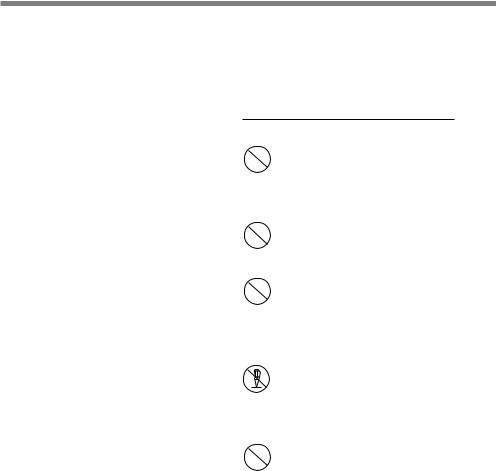
General Precautions
•Keep batteries out of the reach of children.
•If you notice anything unusual when using this product such as abnormal noise, heat, smoke, or a burning odor:
1remove the batteries immediately while being careful not to burn yourself, and;
2call your dealer or local Olympus representative for service.
•Do not expose the rechargeable batteries to water. Do not allow water to contact the terminals.
•Do not remove or damage the battery insulating sheet.
•Do not use the batteries if you find something wrong with them such as leakage, color change or deformity.
•Unplug the charger if the charging is still incomplete after the specified time it should take.
•Should any battery liquid get on skin or clothing, promptly wash it off with clean water.
•Keep batteries away from fire.
 Caution
Caution
•BR402 rechargeable batteries are exclusively for use with Olympus digital voice recorder DS-4000. Do not use them in combination with other equipment.
•Do not subject batteries to strong shocks.
•Do not use with other types of batteries, or with batteries that have different voltages or brand names.
6
•When using more than two batteries, charge them at the same time.
•When using new batteries, or batteries which have not been used for a long time, be sure to recharge them even if they were only used for a short period of time.
Battery Charger (Cradle)
 Danger
Danger
Do not disassemble
•Do not attempt to use this charger with anything other than Olympus Ni-MH batteries. Using it in combination with other batteries may cause fire, explosion, leakage or overheating.
•Do not put the charger in water. Using it when wet or in a humid area (such as a bathroom) may cause fire, overheating or electric shock.
•Do not use the charger with
batteries that have been inserted with their  and
and  terminals reversed. This may cause fire, explosion, leakage, overheating or damage to batteries.
terminals reversed. This may cause fire, explosion, leakage, overheating or damage to batteries.
•Never modify or disassemble the charger. This may cause fire, overheating, electric shock or injury.
 Warning
Warning
•Do not use the batteries if you find something wrong with them such as deformity or leakage. This may cause explosion or overheating.
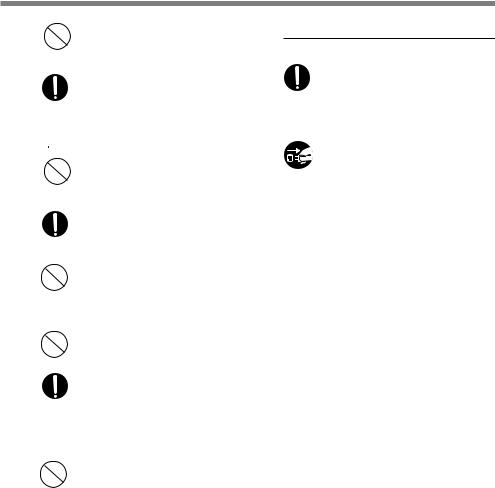
•Do not insert metal wires or similar objects. This may cause fire, overheating or electric shock.
•Keep out of the reach of children. Do not let children use this product without adult supervision.
 Caution
Caution
•Do not charge continuously for more than 3 hours. This may cause explosion, fire, leakage or overheating of batteries.
•Be sure to charge batteries within the temperature range of 0°C - 40°C/32°F - 104°F. If not, there may be explosion, fire, leakage or damage to batteries.
•Do not put anything heavy on the charger or leave it in an unstable position or in a humid place. This may cause explosion, fire, leakage, overheating, electric shock or injury.
•Do not touch the charger for too long when using it. This may cause a serious low-temperature burn.
•If charging does not finish (or if the charge indicator light does not go
off) after three hours, the charger may break. If this occurs, disconnect the power plug and consult your nearest Olympus dealer or customer support center.
•Do not use or store the charger in/ on an unstable place, such as a television set, etc. If it falls, it may cause injury or break.
AC Adapter
 Danger
Danger
Unplug from power outlet
•Be sure to use the charger with the proper voltage (AC 100 - 240 V). Using it with other voltage levels may cause fire, explosion, overheating, electric shock or injury.
•For safety, be sure to unplug the charger from the outlet before performing maintenance or cleaning. Also, never plug in or disconnect the power plug with a wet hand. This may cause electric shock or injury.
 Warning
Warning
•Do not attempt to disassemble, repair or modify the AC adapter in any way.
•Keep foreign objects including water, metal, or flammable substances from getting inside the product.
•Do not moisten the AC adapter or touch it with a wet hand.
•Do not use the AC adapter in the vicinity of flammable gas (including gasoline, benzine and lacquer thinner).
In case
•... the internal parts of the AC adapter are exposed because it has been dropped or otherwise damaged:
•... the AC adapter is dropped in water, or if water, metal flammable substances or other foreign objects get inside it:
•... you notice anything unusual when using the AC adapter such as abnormal noise, heat, smoke, or a burning odor: 7
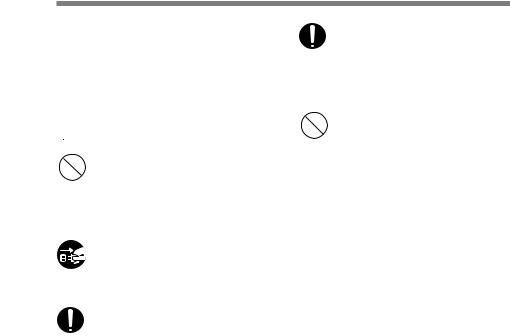
General Precautions
1 do not touch any of the exposed parts;
1 2 immediately disconnect the power supply plug from the power outlet, and; 3 call your dealer or local Olympus representative for servicing. Continued use of the AC adapter under these circumstances could result in electric
shock, fire or injury.
 Caution
Caution
•Do not use the charger if the power plug is damaged or the plug is not completely connected to the outlet. This may cause fire, overheating, electric shock, short circuit or damage.
•Unplug the AC Adapter from AC
|
outlet when not using. If this |
|
Unplug from |
precaution is not followed, fire, |
|
overheating or electric shock may |
||
power outlet |
||
|
occur. |
•Make sure to hold the plug when removing the power plug from
the outlet. Do not bend the cord excessively or put a heavy object on it. This may cause fire, overheating, electric shock or damage.
•If something appears to be wrong with the charger, unplug the charger from the outlet and consult your nearest service center. Using the charger may cause fire, overheating, electric shock or injury.
•Do not use or keep the charger in very hot places, such as in direct sunlight, in a closed car on a sunny day, near a heater, on an electric carpet, etc. Do not use the charger if something is covering it (such as a blanket). This may cause fire, explosion, leakage or overheating.
8

Main Features
●Slide switch operation for ease of use and fast response.
●Dual function cradle, docking station, for recharging of Ni-MH Rechargeable Battery Pack (BR402) ( P.13)*1 and for downloading data from the recorder to a PC ( P.48).
●Two Programmable buttons A and B.
●Recording and storing voice in DSS format.
●Two recording modes, SP (Standard Playback) mode or LP (Long Playback) mode ( P.31).
●Five folders and up to 199 files/folder, for a maximum of 995 recordings ( P.21).
●Built-in Variable Control Voice Actuator (VCVA) function.
●USB Audio Device, recorder can be used as a USB microphone or USB speaker when connected to a PC.*2
●Large LCD screen with backlight.
●Multi-level priority setting ( P.33).
●DSS Player software included ( P.38).
●Hands-free recording function when used with
the optional foot switch (RS25/26).
*1 Available only with the supplied Ni-MH Rechargeable Battery Pack (BR402).
*2 Do not use with Windows 98 as computer operation may become unstable.
IBM and PC/AT are the trademarks or registered trademarks of International Business Machines Corporation.
Microsoft and Windows are registered trademarks of Microsoft Corporation.
Apple, Macintosh, iMac, eMac, Mac, and PowerMac are trademarks or registered trademarks of Apple Computer, Inc.
Intel and Pentium are registered trademarks of Intel Corporation.
Adobe and Acrobat Reader are registered trademarks of Adobe Systems Incorporated.
Other product and brand names mentioned herein may be the trademarks or registered trademarks of their respective owners.
1
Features Main
9

xD-Picture Card
1
Picture-xD Card
The xD-Picture Card is a removable recording media.
Compatible Cards
The removable card can be used to store different kind of data. Since the card has larger memory capacity than a diskette, it can be used to transfer data between different PCs. The recorder supports cards with memory capacity between 16 to 512 MB.
1 Index area |
2 Contact area |
You can write |
Comes into contact |
down the card’s |
with the recorder’s |
contents. |
signal read contacts. |
Memory Sizes of Cards and Approximate Recording Times*1
Memory Size |
SP Mode |
LP Mode |
16MB |
2 hr. 35 min. |
5 hr. 30 min. |
|
|
|
32MB |
5 hr. 10 min. |
11 hr. 05 min. |
|
|
|
64MB |
10 hr. 25 min. |
22 hr. 20 min. |
|
|
|
128MB |
20 hr. 55 min. |
44 hr. 45 min. |
|
|
|
256MB |
42 hr. 00 min. |
89 hr. 40 min. |
512MB |
84 hr. 05 min. |
179 hr. 30 min.*2 |
*1: Available recording time for one continuous file. Available recording time may be shorter if many short recordings are made.
*2: Total recording time of two files. The maximum recording time per file is 99 hours.
.................................................................................................................................................................
Notes
•When initializing (formatting) a card, confirm that no necessary data is stored on the card beforehand. Initialization completely erases the existing data on the card.
•Cards used in a recorder must be formatted in the same recorder first unless formatted with a CAMEDIA series Olympus digital camera. Card may not perform as expected when formatted by a different device.
•The card has a service life. When reaching the end of its life, writing or erasing data on the card will be disabled. In this case, replace the card.
•If you use a PC card adapter compatible with the card to save or delete some data on the card, the maximum recording time on the card may be decreased. To recover the original recording time, initialize/format the
card in the recorder.
10 • Olympus will not be held liable for any data corruption or loss due to misuse of the media card.
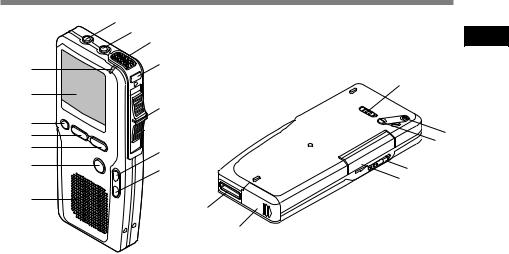
Identification of Parts
|
1 2 |
|
3 |
$ |
4 |
|
|
# |
5 |
|
|
@ |
|
! |
|
0 |
6 |
|
|
9 |
7 |
|
|
8 |
- |
|
)
%
&^
(*
1
of Identification
Parts
1EAR jack |
@ERASE button |
2MIC jack |
#Display (LCD panel) |
3Built-in microphone |
$Record/Play indicator lamp |
4NEW button |
%POWER (ON/OFF) switch |
5Slide (REC/STOP/PLAY/REV) switch |
^VOLUME (+) button |
6FF (Fast Forward) button |
&VOLUME (–) button |
7REW (Rewind) button |
*Card cover lock |
8Built-in speaker |
(Card cover |
9MENU button |
)Battery cover |
0B button (Programmable) |
-PC (USB) terminal/Cradle attachment |
!A button (Programmable) |
point |
11
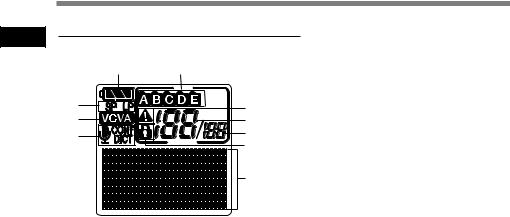
1
of Identification
Parts
Identification of Parts
Display (LCD Panel)
1 |
2 |
|
0 |
3 |
|
9 |
||
4 |
||
8 |
5 |
|
|
6 |
|
|
7 |
1Battery indicator
2Folder
3Priority indicator
4Current file number
5Total number of recorded files in the folder
6Erase lock indicator
7Character Information display
8Microphone sensitivity display
9VCVA (Variable Control Voice Actuator) indicator
0Record mode indicator
12
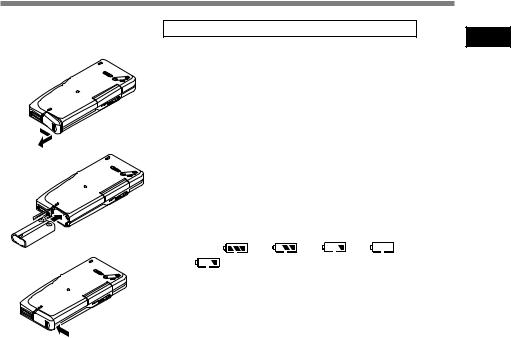
Installing Batteries
|
Ni-MH Rechargeable Battery Pack (BR402) |
||||
1 |
Lightly press down on the arrow and slide the |
||||
1 battery cover open. |
|
|
|||
|
Insert Ni-MH Rechargeable Battery Pack, |
||||
|
2 observing the correct polarity. |
|
|||
2 |
3 Close the battery cover completely. |
||||
The battery needs to be charged when you use the recorder |
|||||
|
for the first time after purchase ( P.14). |
||||
|
Recharging batteries |
|
|
||
|
The battery indicator on the display changes as the batteries |
||||
|
lose power. |
→ |
→ |
→ |
|
3 |
|
||||
When |
appears on the display, charge the batteries as |
||||
|
|||||
soon as possible.
When the battery is too weak, the recorder shuts down and “BATTERY LOW” appears on the display.
.................................................................................................................................................................
Notes
•Removing the battery pack while the recorder is in use may corrupt the file. If you are recording into a file and the battery run out, you will lose your currently recorded file since the file header will not be written. It is crucial to charge the batteries once you see only one hash mark in the battery icon.
•Remove the battery pack if you are not going to use the recorder for an extended period of time.
1
Batteries Installing
13
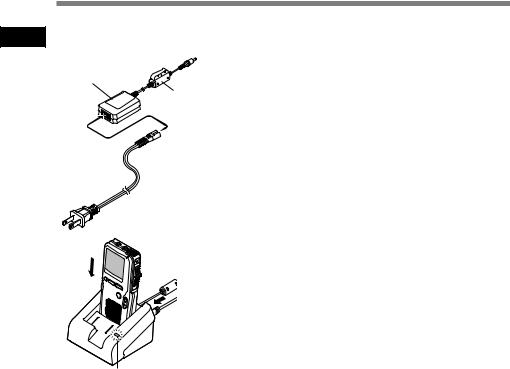
1
Battery Charging
Charging Battery
You can charge the Ni-MH Rechargeable Battery Pack in the recorder when you set the recorder in the cradle. The battery is usually shipped partially charged. You need to charge the battery before first use.
|
Connect the AC adapter or USB cable to the |
AC adapter |
1 cradle. |
|
|
AC cable |
For connection procedures, see P.44. |
AC |
When using the adapter for charging, connect the power plug |
connector |
|
|
to the charger’s AC connector. |
The plug type varies depending on the country where sold.
2 Turn ON the recorder and, remaining the slide switch at the STOP position, set it vertically in the cradle.
CHARGE indicator lamp glows red and the charging starts. The lamp goes out when the charging is complete.
CHARGE indicator lamp
.................................................................................................................................................................
Notes
• Charge the battery often for first few uses. Battery performs better after several full charge/discharge cycles.
• Batteries other than the supplied battery cannot be charged.
• If you charge the battery right after charging is complete, it will take only few minutes to charge the battery.
• The PC must be ON when charging battery via the USB cable connection.
• Charging battery via the USB cable connection may not be successful depending on the power supply capacity of your PC. Use the AC adapter instead.
• If you change the recorder toAUDIO device while charging battery only via the USB cable connection, charging may stop.
• Do not set or remove the recorder from the cradle while it is in operation. 14 • You can charge the battery while the recorder is in operation.
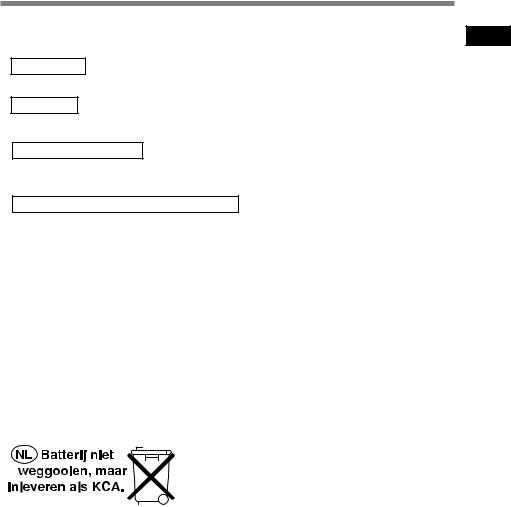
Information Regarding Rechargeable Batteries
These batteries are exclusively for use with Olympus voice recorder DS-4000. Never use them in combination with other equipment.
Discharging
Batteries self-discharge while they are not in use. Be sure to charge them regularly before use.
Battery life
Charging and discharging are possible for approximately 500 times depending on usage.
Operating temperature
Batteries are chemical products. Battery efficiency may change even when operating within the recommended temperature range, but this is not a malfunction.
Recommended temperature range for use
Discharging (when using appliance): 0°C - 50°C/32°F - 122°F Charging: 0°C - 40°C/32°F - 104°F
Storage: –20°C - 30°C/–4°F - 86°F
Using the batteries outside the above temperature range may result in declining efficiency and shorter battery life.
In order to prevent battery leakage or rust, remove the batteries from the products when you will not be using them for a long time, and store them separately.
.................................................................................................................................................................
Notes
This charger is designed to fully charge batteries regardless of their energy level. However, for best results when charging newly purchased batteries or batteries that have not been used for a long time (more than one month), It is recommended to fully charge the batteries, then discharge them. Repeat two or three times.
•When you dispose dead batteries always observe the laws and regulations regarding the disposing of such items.
•If Ni-MH rechargeable batteries are not fully discharged, protect against short-circuiting (e.g. by taping the contacts) before disposing.
For customers in Germany
1
Regarding Information
Batteries Rechargeable
Olympus has a contract with the GRS (Joint Battery Disposal Association) in Germany to
ensure environmentally friendly disposal.
15
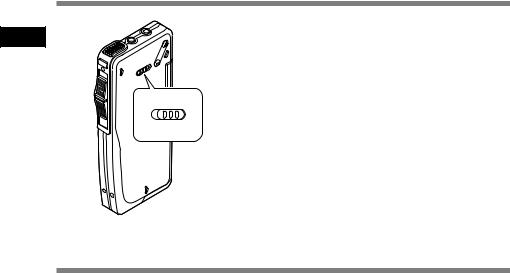
1
ON Turning
Recorder/ the Save Power Mode
Turning ON the Recorder
With the battery charged in the recorder and the card inserted properly, the recorder is ready to work.
While the power switch on the back of the recorder is in the OFF position, none of the buttons or switch on the recorder will be active. Slide the power switch to the ON position to activate the recorder.
POWER
ON OFF
Power Save Mode
When the recorder is ON but not in use for 10 minutes, by default, it will switch to power save mode automatically. To reactivate the recorder again, press any of the buttons on the recorder.
16
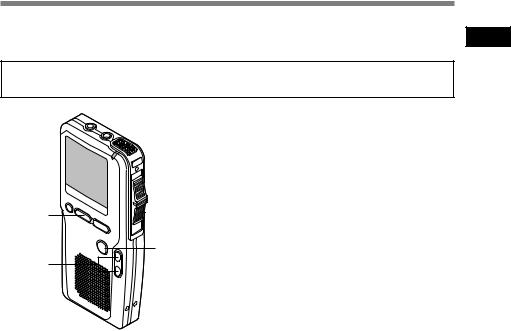
Setting Time/Date (TIME&DATE)
Setting the correct time and date on the recorder is very important since every file recorded on the recorder will have the date and time information as part of the file header. This will simplify the file management aspects later on.
The hour indicator will flash automatically when you load batteries before using the recorder for the first time, or after the recorder hasn’t been used for a long time.
A button
(switching the data displayed)
FF/REW button
(alters a choice)
MENU button
(accepts a choice and moves on to the next item)
1 Set the hour.
1 Press the FF button or REW button to set the hour.
2 Press the MENU button to accept the hour.
•You can choose between 12 and 24 hour display by pressing the A button while setting the hour and minute.
Example: 5:45 P.M.
5:45 PM ←→ 17:45 (Initial setting)
2 Set the minute.
1 Press the FF button or REW button to set the minute.
2 Press the MENUbutton to accept the minute.
3 Set the year.
1 Press the FF button or REW button to set the year.
2 Press the MENU button to accept the year.
•You can choose a different date format by pressing the A button while setting the date.
1
Time/Date Setting
TE)(TIME&DA
17
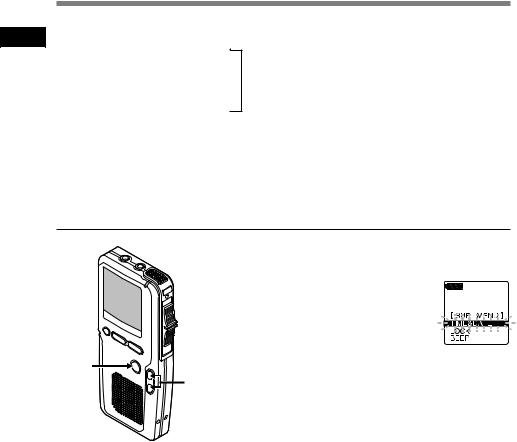
1
Time/Date Setting
TE)(TIME&DA
4 1 Press the FF button or REW button to set the month.
2 Press the MENU button to accept the month.
5 Set the day.
1 Press the FF button or REW button to set the day.
2 Press the MENU button to accept the day’s date.
..........................................................................
Notes
•If you move the slide switch to a position other than STOP mode, the recorder will save the items that were set to that point.
•You can set the time and date from your PC using DSS Player software ( P.38).
Changing the Time/Date
|
|
|
Press the MENU button. |
|
|
1 The menu appears ( P.31). |
|
|
|
2 |
Press the FF or REW button until |
|
|
“TIME&DATE” flashes on the display. |
|
1,3,4 |
2 |
|
Press the MENU button. |
|
Time/Date screen appears. The hour |
||
|
3 indicator flashes, indicating the start of the |
||
|
|
|
Time/Date setup process. |
|
|
|
Follow the same steps starting at step 1 in |
|
|
4 |
“Setting Time/Date” ( P.17). |
|
|
Press and hold the MENU button for |
|
|
|
1 second or longer to close the |
|
menu.
18
